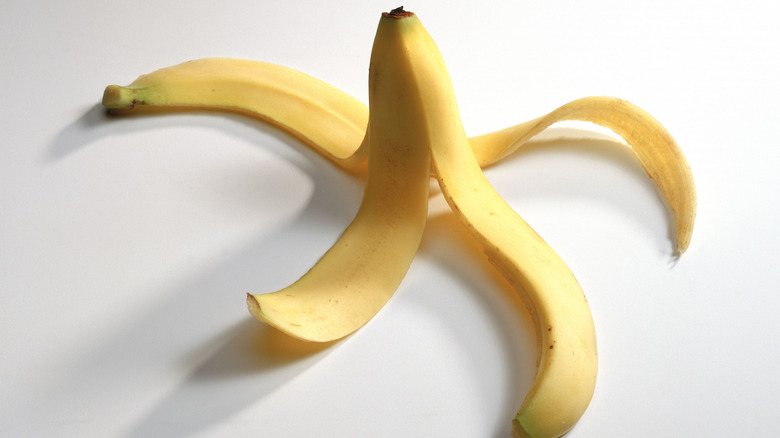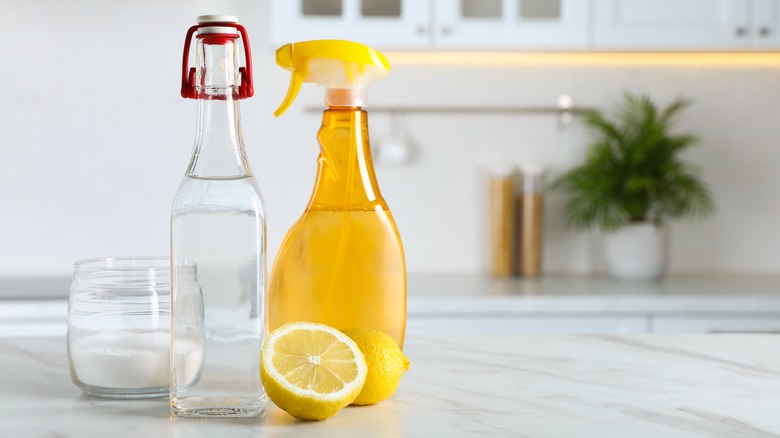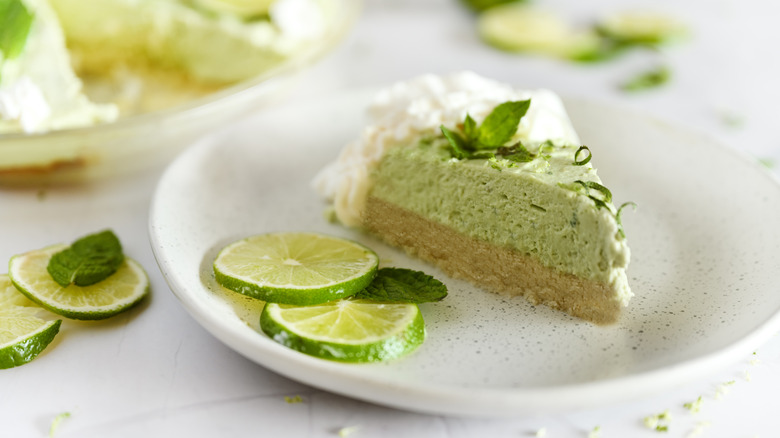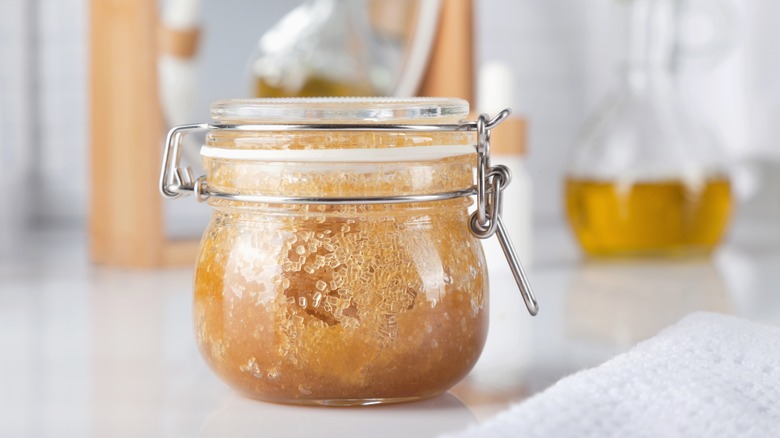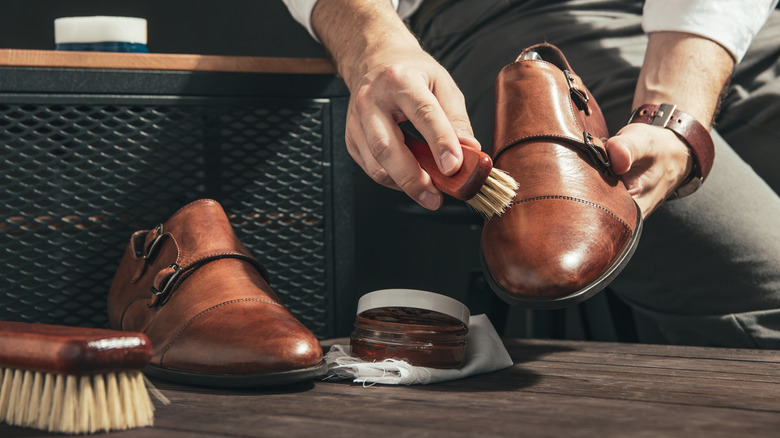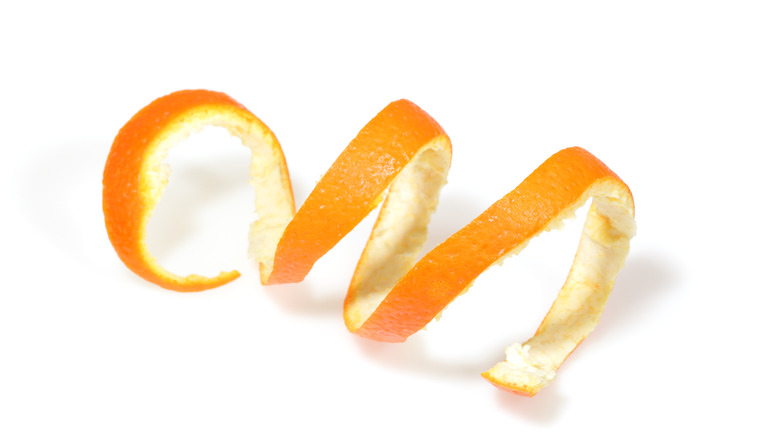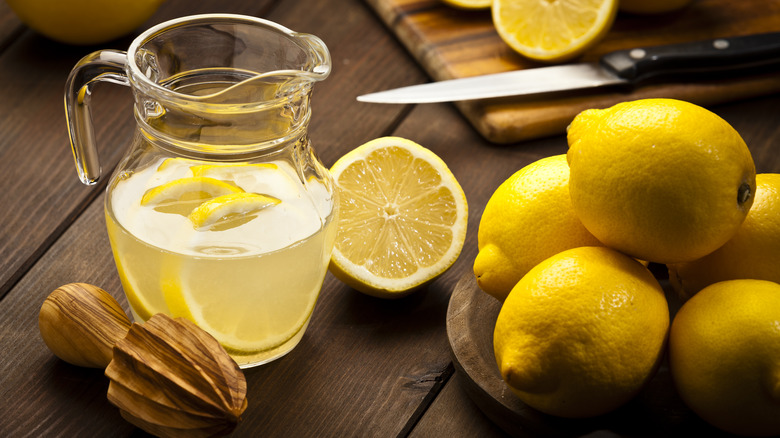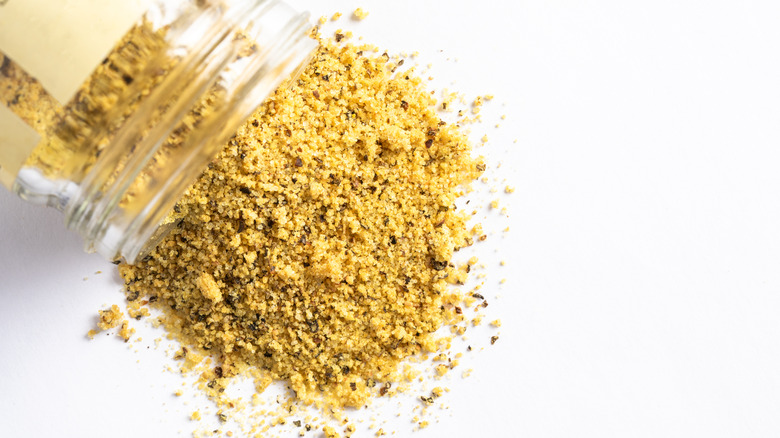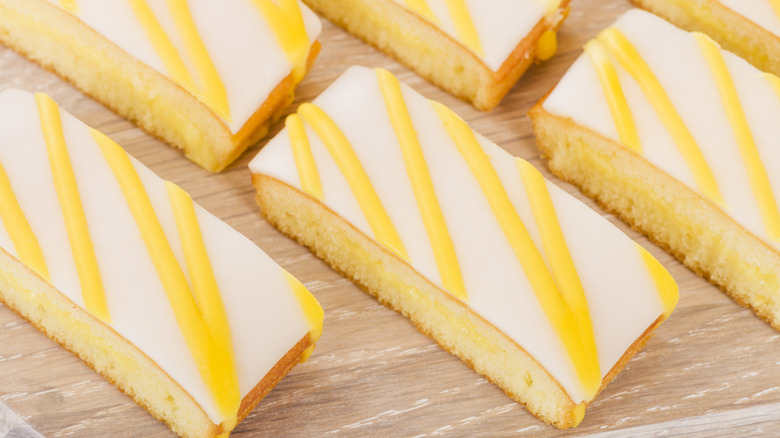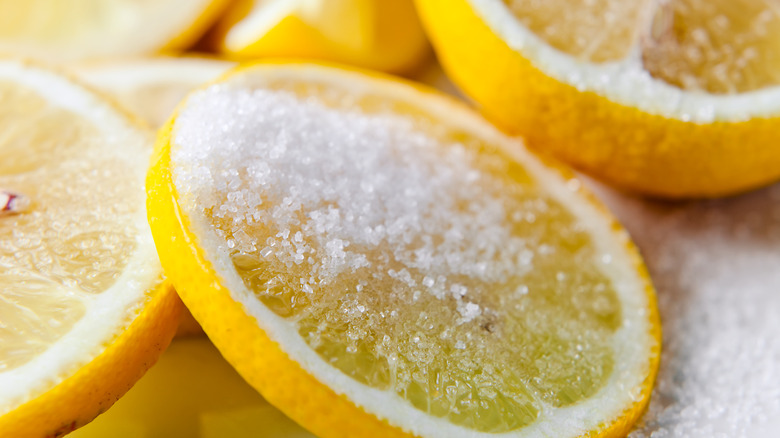The Most Useful Ways To Use Leftover Fruit Peels
When it comes to fruit, it's easy to forget that peels actually have a use. After all, peels typically don't taste good on their own and, as such, are usually tossed in the trash without much of an afterthought. But what if we told you there are useful and potentially health-boosting ways to put mundane fruit peels to use that you've probably never even heard of?
That's right! Those fruit peels you're throwing away may actually improve your life in more ways than one. In fact, we've come up with 15 truly amazing ways you can use fruit peels that will undoubtedly dissuade you from ever tossing them out again. From easier cleaning experiences to making simple and yummy recipes, we promise you'll find several ways to put those peels to good use. So, without further ado, let's get started on our very best tips for making use of leftover fruit peels.
1. Cleaning solution
Love a good DIY? Why not make your own cleaning solution? Use citrus peels to create a totally effective (and amazing-scented) cleaner that is just as good for your messy surfaces as it is for the environment.
To make a citrus cleaning solution, you'll first want to gather up your fruit peels. Orange and lemon tend to work best since both pack grease-fighting qualities that make this DIY solution effective. Place your citrus peels in a mason jar along with vinegar.
Now, for the hard part. You have to let this solution sit for at least two weeks. Once this long waiting period ends, strain your solution, and you're done. Add your newfound liquid cleaner to an empty spray bottle and spray away. Bonus points for adding a few sprigs of fresh herbs to the mix — rosemary, thyme, sage, and oregano are excellent options that offer an awesome scent when combined with citrus.
2. Zest for dessert
If you're a seasoned at-home cook, you likely already know how dynamic adding a bit of zest to an already flavorful dessert can be. This unexpected but effective way to impart flavor to a dessert offers a swift approach to using lemon or orange peels, and you don't have to worry about the added liquid from using actual citrus juice ruining your recipe to boot.
There are plenty of desserts out there that call for fruit zest and even a few savory dishes that can benefit from it, as well. So, how do you zest peels? It's fairly simple. You'll want to take a fine, handheld grater and grate your peels over it. This is easier done when the fruit is still entirely intact, though using just the peels can yield the same results. Just be careful not to slice your fingers in the process.
As you grate the fruit against the grater, tiny "flakes" will cascade about. These flakes are the "zest" you'll add to whatever recipe calls for it. Zesting works best with lemons, limes, oranges, and other citrus fruits.
3. Body scrub
Now, onto a hack that will benefit your body directly, and that's converting your unused fruit peels into a DIY body scrub. Yep, it's true; you can finally stop wasting hundreds of dollars on expensive scrubs by making your own at home. Use your fruit peels in scrubs not only for aesthetic and scent purposes but also as a direct benefit to your skin. While you could technically use several types of peels for your body scrub, you should know that lemon and orange peels contain citric acid, which can help exfoliate the skin and promote a smooth and youthful appearance.
To make a fruit peel body scrub, simply combine the zest of fruit and combine it with sugar and a bit of oil. Stir the mixture together, and voila. You've got a body scrub that'll improve your complexion and smooth the skin on your entire body. How awesome is that?
4. Shoe shiner
Don't look at us like that. Banana peels really do make for an excellent shoe shiner, even if it does make you look a bit weird for doing it. Since bananas are packed with potassium, they actually make leather look great. In fact, this very nutrient makes up the main component of many commercialized leather shoe shiners. Thus, it would make sense that using a banana peel would provide similar results, and for much cheaper, we might add.
To take on this oddly effective remedy, simply eat a banana (that's the fun part, right?), then take the banana peel and turn it inside out. Rub the inside of the peel against the exterior of your leather shoes. After you've finished polishing your shoes with your morning snack, go ahead and retrieve a clean, dry washcloth to wipe off the remaining banana residue.
Take a step back and enjoy the benefits of freshly shined shoes.
5. Make a snack
Did you know you can actually eat most fruit peels? Most of us don't because some fruit peels, like citrus skin, obviously don't taste good on their own. But what if we told you there's a way you can actually make fruit peels taste amazing with only a few simple ingredients? Believe it or not, you can. Take candied orange peels, for example. They're coated in granulated sugar along with a bit of vanilla extract and cooked to perfection on a hot stove until they're soft, sugar-coated, and oh-so flavorful. The same can be done with lemon peels and other fruit peel types.
This is a great way to enjoy fruit peels, especially because so many of them are loaded with vitamins and nutrients your body could greatly benefit from. And though they are technically coated in sugar, this recipe still acts as a great way to prevent creating more waste by inventing a fun, tasty, and creative way to use up your fruit scraps. Who knew?
6. Use as fire starter
If you're longing for something that smells warm, crisp, and comforting for your autumn night bonfire, why not put your fruit peels to use? We've found that citrus skins make excellent fire starters, with orange being our favorite scent of them all. Be careful, though. When using citrus peels for fire, you'll always want to dry them out first before adding them to a flame.
To dehydrate your citrus peels, simply place them in a dehydrator or the oven on very low heat. You can make fire starter peels with lemon, orange, lime, or even grapefruit peels; just be sure to select a "fragrance" you're certain you'll be happy with. Once your peels are completely dried out, add them underneath your typical wood pile and light a match. From here, you can enjoy the inviting citrusy smells alongside crackling wood and the warmth from the blaze. What better way to enjoy a crisp fall evening or tranquil summer's night?
7. Make a tea
Now, this might not be such a novel idea, but trust us, the flavor payoff is well worth it. Making tea out of your fruit peels is an inexpensive yet totally effective way to make a flavorful and potentially health-boosting fruit tea.
To make fruit peel tea, simply take the fruit peels of your choice, ensuring they are fresh and clean before use. Simmer the fruit peels in the amount of water you plan to use for tea, plus a little extra to compensate for any water that evaporates during the boiling process.
Let the water come to a boil and simmer for about 2-3 minutes or until the water changes color. Remove the tea from the heat and allow it to sit for a few minutes. Douse your tea with honey and a splash of cream if desired. Other aromatics, such as clove, cinnamon, or even the use of fresh herbs, are wonderfully playful ways to spruce up this fruit tea and make it even more inviting. Experiment and see what you come up with.
8. Flavorize your water
Another great way to sip your fruit peels is to use them in water. Though there are many ways to infuse water with flavor, using fruit peels in this way is one of the smartest methods, as it maximizes those leftover fruit bits that might have been tossed out otherwise. The result is nutritious water with potential benefits that involve reducing the risk of kidney stones, particularly if you're using boiled lemons to achieve this flavorful treat (via Healthline).
So, how is adding flavor to water done? Simply take your fruit peels and boil them as you would tea. This time, however, you'll want to allow the water to cool completely. Strain the boiled water and store it in the fridge. Once chilled, it's time to enjoy your freshly flavored water. This is a great option for people who often feel dehydrated but hate the dull taste of average water. This works great with lemon peels, orange peels, and lime peels but will also work with virtually any other fruit peel.
9. Pest control
Did you know that you might be able to use orange peels to get rid of pests in your garden? We certainly didn't. But after doing some research, we found that orange peels make a great repellent for pesky bugs and insects.
Apparently, the smell of citrus, though pleasant to our nostrils, doesn't quite smell as pleasing to pests. As a result, placing orange peels near your plants can help keep bugs away and help you maintain your garden and sanity.
To use orange peels to protect your plants, you can approach the task a couple of ways. The first would be to simply take your old orange peels and chop them up into tiny pieces. Scatter the orange pieces all over your yard, particularly around your plants' bases. Alternatively, boil your orange peels in water for about 10 minutes. Once boiled, allow the water to cool. Then, transfer the water to a spray bottle. Spray this mixture on and around your plants every three days for the best results.
10. Soothe nasty bug bites
It's one thing to have pests ransacking your garden, but it's quite another to have them attacking your skin. Believe it or not, fruit peels can actually soothe the pain and irritating itch of a mosquito bite. Though you may find yourself with many kinds of fruit peels on hand, it is banana peels that we've found to be most effective for dealing with the vexation that uncomfortable bug bites often bring.
To use a banana skin for soothing and healing purposes, simply eat (or peel) a banana, turn the peel inside out, and rub the inside of the banana along the bug bite site. After a few minutes of application, you should start to feel relief. We're guessing it's the moisturizing properties as well as the nutrients in banana peels that cause it to be so effective for calming that uncomfortable itch. Either way, it's another free yet effective way to use fruit peels to your benefit.
11. Freshen your dishwasher
We are willing to bet you've never considered throwing your citrus peels in the dishwasher but trust us; this is a hack worth looking into. We know that lemon and orange peels, in particular, work great for cleaning purposes. As a result, running orange or lemon peels through your dishwasher can have surprisingly beneficial effects on your dishwasher regarding the scent. It can even make your dishes come out a bit cleaner too.
So, how can it be done? Simply place your lemon or orange (or other citrus) peels on the top rack of your dishwasher. A simple wedge of lemon or orange will do just fine, and no, the flesh doesn't need to be present for this to work. Run your dishwasher as normal, and upon the finished cycle, you'll likely notice fresher-smelling and cleaner dishes. It's easy, effective, and cuts down on waste. What could be better?
12. DIY seasoning
Surely, you've heard of lemon pepper seasoning. This bright and spicy flavor enhancer is often used on chicken and other meats, but did you know you could just as easily make your own fruit peel seasoning at home? You can, and the process is fairly straightforward.
Now, we can only vouch for making a lime, orange, or lemon seasoning here, but you could experiment with other fruit peels here to see what flavorful seasoning combinations you can come up with. Simply place the zest of your choice in a toaster or conventional oven at a very low heat setting until you've completely dried out the zest. Once dried, you'll pulverize the zest with the pepper until the consistency mimics a really fine seasoning grain.
Take your newfound DIY fruit peel seasoning and apply it to whatever dish you wish. The results should be the strong taste of black pepper along with a bright hint of whatever fruit peel you've chosen to add to the mix.
13. Make a baking extract
If you've ever wondered how baking extract is made, now's your chance to find out on your own. Making a delicious-tasting extract from fruit peels is very straightforward, although, much like making a fruit peel all-purpose cleaner, it'll take some time before you can use it.
To make your own fruit extract for cooking, take a bit of the zest of your choice (lemon, orange, and lime work well) and use a ribbon zester to cut neat ribbons of zest from your fruit. Alternatively, you could cut thin strips yourself by hand; just know it'll be a longer process. As you are zesting, ensure you don't include any white pith of your fruit if you use citrus peels. This may throw off the taste of your extract a bit.
Once you've got your fruit zested, place the zest in a glass bottle and fill the rest of it up with vodka. Allow it to sit between 5-8 weeks, depending on the strength of flavor you're going for. Use a small amount anytime you want to impart flavor to your baked goods.
14. Make sugar
If you've never attempted to make sugar infused with zest, you don't know what you're missing. Adding a bit of citrus zest to sugar is a terrific way to add flavor to your sugar and give it an interesting zip whenever you're cooking or baking. Some like to use flavored sugar for margarita rims, while others might use a bit of it in lemonade. What's even more exciting about this fruit peel hack is that assembling zesty sugar only takes two ingredients, making it ridiculously easy to make.
To make fruit peel sugar, simply zest a citrus fruit of your choice. Make sure that the skin of the citrus fruit is clean and dry prior to zesting. Take your zest and mix it with your sugar. That's it! As far as the sugar-to-zest ratio goes, you may want to aim for one tablespoon for every ¼ cup of sugar. Store your tasty mixture in an airtight container for one day at room temperature if using fresh zest, or up to three months if using dehydrated zest for optimal flavor.
